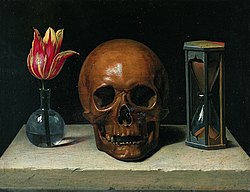Featured Artwork of the Day: Jacques de Gheyn II (Netherlandish, 1565–1629) | Vanitas Still Life | 1603 http://met.org/1JUIt2k
此條Memento mori,為西方藝術史的基本知識。

Earthly Vanity and Divine Salvation by Hans Memling. This triptych contrasts earthly beauty and luxury with the prospect of death and hell.
Contents
[hide][edit] Historic usage
[edit] Classical
[edit] Medieval Europe
The most obvious places to look for memento mori meditations are in funeral art and architecture. Perhaps the most striking to contemporary minds is the transi, or cadaver tomb, a tomb which depicts the decayed corpse of the deceased. This became a fashion in the tombs of the wealthy in the fifteenth century, and surviving examples still create a stark reminder of the vanity of earthly riches. The famous danse macabre, with its dancing depiction of the Grim Reaper carrying off rich and poor alike, is another well known example of the memento mori theme. This and similar depictions of Death decorated many European churches. Later, Puritan tomb stones in the colonial United States frequently depicted winged skulls, skeletons, or angels snuffing out candles. These are among the numerous themes associated with skull imagery.
A version of the theme in the artistic genre of still life is more often referred to as a vanitas, Latin for "vanity". These include symbols of mortality, whether obvious ones like skulls, or more subtle ones, like a flower losing its petals. See the themes associated with the image of the skull.
Memento mori was also an important literary theme. Well known literary meditations on death in English prose include Sir Thomas Browne's Hydriotaphia, Urn Burial and Jeremy Taylor's Holy Living and Holy Dying. These works were part of a Jacobean cult of melancholia that marked the end of the Elizabethan era. In the late eighteenth century, literary elegies were a common genre; Thomas Gray's Elegy Written in a Country Churchyard and Edward Young's Night Thoughts were typical members of the genre.

Prince of Orange René de Châlons died in 1544, at age 25. His widow commissioned sculptor Ligier Richier to represent him offering his heart to God, set against the painted splendour of his former worldly estate. Church of Saint-Étienne, Bar-le-Duc.
- Vita brevis breviter in brevi finietur,
- Mors venit velociter quae neminem veretur,
- Omnia mors perimit et nulli miseretur.
- Ad mortem festinamus peccare desistamus.
- Life is short, and shortly it will end;
- Death comes quickly and respects no one,
- Death destroys everything and takes pity on no one.
- To death we are hastening, let us refrain from sinning.
- Ni conversus fueris et sicut puer factus
- Et vitam mutaveris in meliores actus,
- Intrare non poteris regnum Dei beatus.
- Ad mortem festinamus peccare desistamus.
- If you do not turn back and become like a child,
- And change your life for the better,
- You will not be able to enter, blessed, the Kingdom of God.
- To death we are hastening, let us refrain from sinning.
Another example of memento mori is provided by the chapels of bones, such as the Capela dos Ossos in Évora or the Capuchin Crypt in Rome. These are chapels where the walls are totally or partially covered by human remains, mostly bones. The entrance to the former has the sentence "We bones, lying here bare, await for yours".
The motto of the French village of Èze is the phrase: "Moriendo Renascor" (meaning "In death I am Reborn") and its emblem is a phoenix perched on a bone.
[edit] Puritan America
Colonial American art saw a large number of "memento mori" images due to Puritan influence. The Puritan community in 17th century North America looked down upon art because they believed it drew the faithful away from God, and if away from God, then it could only lead to the devil. However, portraits were considered historical records, and as such they were allowed. Thomas Smith, a 17th century Puritan, fought in many naval battles, and also painted. In his self-portrait we see a typical puritan "memento mori" with a skull, suggesting his imminent death.The poem under the skull emphasizes Smith's acceptance of death:
Why why should I the World be minding, Therein a World of Evils Finding. Then Farwell World: Farwell thy jarres, thy Joies thy Toies thy Wiles thy Warrs. Truth Sounds Retreat: I am not sorye. The Eternall Drawes to him my heart, By Faith (which can thy Force Subvert) To Crowne me (after Grace) with Glory.
[edit] See also
- Ars moriendi
- Ash Wednesday
- Danse Macabre
- Elegy
- Epitaph
- Et in Arcadia ego
- List of Latin Phrases
- Lament
- Post-mortem photography
- Sic transit gloria mundi
- Ubi sunt
- Vanitas
[edit] References
- ^ Apologeticus, Chapter 33,4.
[edit] External links
| Wikimedia Commons has media related to: Memento mori |
- Isaiah 22
- Apologeticus
- Memento mori and vanitas elements in the funerary art at St. John's Co-Cathedral, Valetta, Malta, an article on memento mori and ars moriendi appearing in the journal "Treasures of Malta", December 2004.







沒有留言:
張貼留言